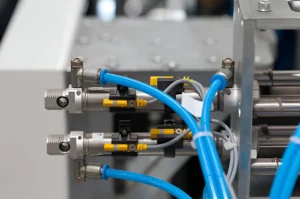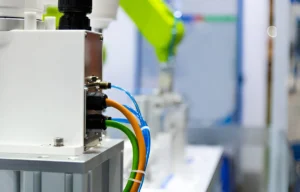올바른 크레인 리모컨을 선택하는 방법은?
올바른 크레인 리모컨을 선택하는 것은 크레인을 사용하는 모든 산업 작업에서 중요한 결정입니다. 투박하고 오래된 리모컨으로 크레인을 제어하는 것과 안전, 효율성, 생산성을 높여주는 매끄럽고 인체공학적인 시스템으로 크레인을 제어하는 것의 차이를 상상해 보세요. 리모컨을 잘 선택하면 작업 방식을 혁신하여 작업을 더 원활하고 안전하게 [...] 만들 수 있습니다.


Imagine a device that can detect objects without even touching them—sounds like something out of a sci-fi movie, right? Well, capacitive proximity switch sensors make this possible in the real world! These clever little gadgets are everywhere, from your smartphone screen to industrial automation systems. But how do they work, and why should you care? Buckle up, because we’re diving deep into the world of capacitive sensing!
A capacitive proximity switch sensor is an electronic device that detects nearby objects without physical contact. Unlike mechanical switches, which require a button press, capacitive sensors work by sensing changes in an electrical field. Think of it like a silent guardian—always watching but never touching.
These sensors are widely used in consumer electronics, automotive systems, and industrial machinery. Ever wondered how your phone knows when your face is near the screen? Yep, that’s capacitive sensing in action!
At its core, a capacitive sensor operates like an invisible force field. It generates an electrostatic field and monitors disturbances caused by conductive or dielectric objects. When something enters this field, the sensor detects a change in capacitance (the ability to store an electrical charge) and triggers a response.
Electrostatic Field
Capacitance Change
Signal Processing
It’s like throwing a pebble into a still pond—the ripples tell you something’s there.
Wondering what makes these sensors tick? Here’s a breakdown:
1. Oscillator Circuit: Generates the electric field.
2. Sensor Electrode: The part that interacts with the external object.
3. Signal Conditioner: Amplifies and processes the detected signal.
4. Output Stage: Converts the signal into a usable output (e.g., a switch signal).


Not all capacitive sensors are created equal. Here are the main types:
Shielded
Unshielded
Why choose capacitive over other types? Here’s why:
Non-Contact Operation: No wear and tear.
다용도성: Works with liquids, plastics, and metals.
내구성: Resistant to harsh environments.
High Sensitivity: Detects even minute changes.
These sensors are everywhere! Some popular uses include:
Smartphones
산업 자동화
자동차
Home Appliances


Here’s a concise list-based comparison of capacitive and inductive proximity sensors for your blog:
Picking the perfect sensor? Consider these factors:
1. **Material of Target Object** (conductive vs. non-conductive).
2. **Detection Range** (how far should it sense?).
3. **Environmental Conditions** (humidity, temperature).
4. **Output Type** (digital, analog, or IO-Link).
Want your sensor to last? Follow these best practices:
Mount Properly
Calibrate Sensitivity
Clean Regularly
The future looks bright! Expect:
🔹 **Miniaturization**: Smaller, more compact sensors.
🔹 **AI Integration**: Smarter detection algorithms.
🔹 **Energy Efficiency**: Lower power consumption.
Capacitive proximity switch sensors are the unsung heroes of modern tech, blending precision with versatility. Whether you’re designing a smart device or optimizing a factory line, these sensors offer a reliable, touch-free solution. Ready to harness their power?
Most sensors have a range of a few millimeters to about 50mm, depending on the object’s material and sensor type.
Yes, but only if the wall is thin and non-metallic. Thick or conductive materials block the electric field.
Absolutely! They’re great for liquid detection and humid conditions, unlike some optical sensors.
This could be due to environmental noise, improper grounding, or incorrect sensitivity settings.
They’re generally affordable, with prices varying based on features like adjustability and shielding.
Got more questions? Drop them in the comments—we’d love to help! 🚀